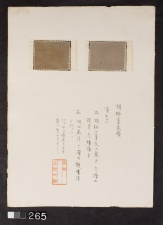Difference between revisions of "Kurumi (Walnut) - left (265 L)"
Jump to navigation
Jump to search
(username removed) |
(username removed) |
||
| Line 5: | Line 5: | ||
| 265 | | 265 | ||
|- | |- | ||
| − | ! scope="row"| | + | ! scope="row"|Uemura number / title |
| − | | | + | | ; "Haze-some 25" |
|- | |- | ||
! scope="row"|Folder location | ! scope="row"|Folder location | ||
| Line 44: | Line 44: | ||
| - | | - | ||
|- | |- | ||
| − | ! scope="row"| | + | ! scope="row"|Uemura's notes |
| The resultant colors were in pale tone. Better result would be obtained when using the peels of those younger fruit. | | The resultant colors were in pale tone. Better result would be obtained when using the peels of those younger fruit. | ||
|- | |- | ||
| − | ! scope="row"| | + | ! scope="row"|Uemura's date |
| Kyoto | | Kyoto | ||
|} | |} | ||
| − | [[Category: | + | [[Category:Uemura dye archive]] |
Revision as of 07:19, 24 July 2013
| Museum number | 265 |
|---|---|
| Uemura number / title | ; "Haze-some 25" |
| Folder location | 4th shelf |
| Sample location | left (265 L) |
| Fiber type | cotton |
| Color | light grayish brown |
| Dyestuff (Japanese common name) | 胡桃 : Kurumi |
| Dye (English common name) | Walnut tree |
| Dyestuff (botanical name) | Juglans mandshurica Maxim. var. sachalinensis (Miyabe et Kud) Kitam. (J. mandshurica var. sieboldiana (Maxim.) Makino) |
| Plant part | green outer skin / unspecified |
| Dyestuff extraction | boiled in water |
| Auxiliary agent in dye bath | - |
| Mordant | iron |
| Other auxiliary agent | - |
| Uemura's notes | The resultant colors were in pale tone. Better result would be obtained when using the peels of those younger fruit. |
| Uemura's date | Kyoto |
